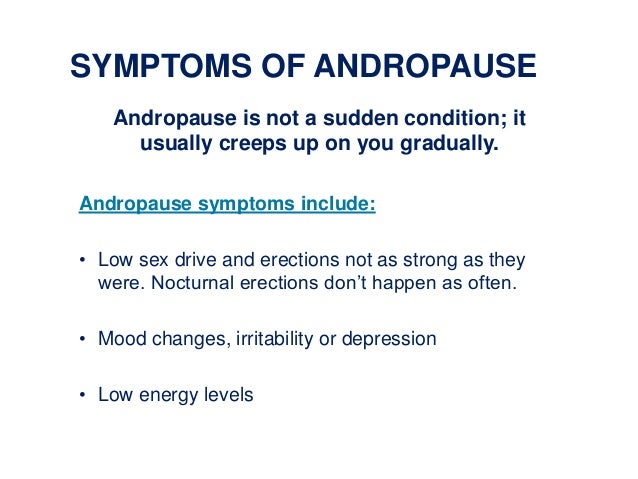
The term "male menopause" is supposed to describe the condition of males that have a androgen production drop beyond mid-life.
"Manopause" is a subject of dispute among scientific researchers. In the case of ladies, menopause is associated with the discontinuation of a biological operation - primarily, when the monthly menstruation ceases. Additionally, a vital drop in the hormone production in females takes place along with menopause. Because of these factors, researchers are questioning whether andropause truly exists.
In the case of males in their middle or elderly years, less amounts of testosterone are being produced via the testicles. This is believed to be the underlying factors behind the appearance of signs of andropause.
Guys with andropause typically suffer from grouchiness, sleep difficulties, declining sex drive, sweating, anxiousness, despair, memory troubles, as well as ED.
For the most part, impotence could be triggered by other problems - and yet, testosterone shortage might be one reason.
It is important that men who struggle with signs associated with reduced production of testosterone schedule medical analysis for blood screening to evaluate testosterone output.
Various other reasons for having diminishing testosterone output include a testicular dysfunction or a potential inherited condition.
As a treatment, hormone replacement therapy is being advised for guys with reduced amounts of testosterone as well as the signs and symptoms that are associated with it.
HRT might not apply to older men who seek treatment for their impotence unless they actually have extremely minimal levels of androgens. As for more youthful men with well-known hormone deficiency, it has been confirmed that nominal doses of testosterone can enhance passion in sex.
Testosterone replacement therapy, which is also called androgen HRT, aims to reduce the signs brought about by male menopause. This technique is a long-lasting therapy, because testosterone shortage is usually a long-term condition.
HRT is normally given as a sublingual prescription, implants, or shots.
The injection of testosterone is normally administered as soon as every two weeks.
The sublingual medicines are specifically recommended to those that cannot tolerate shots or implants.
The testosterone implants, which are being placed under the skin of the butt cheek or abdominal area help a period of months. The implant functions by introducing testosterone directly withiin the bloodstream.
HRT, nonetheless, can have associated negative effects as well as risks.
With reduced testosterone levels, the prostate may shrink. HRT can not recuperate a physically shrunken prostate considering that it does not have influence in the degrees of prostate-specific antigen.
Hormone replacement might not be a source of enhanced danger of prostate cancer for those that have normally greater testosterone production in the same age bracket.
On the flip-side, the safety and security of hormonal replacement as well as it's feasible impacts on the prostate gland, psychological healthfunctioning, as well as cardiovascular system still have to undergo proper investigation. In addition, there is likewise a need to assess the potential benefits of androgen therapy on the bones and also muscular tissues.
Androgen treatment is claimed to boost the risk of heart diseases, although examination on this topic is uncertain. It is a well-known truth, however, that those with reduced testosterone levels have been seen among heart attack sufferers. This opens the opportunity that hormone replacement therapy could assist prevent heart diseases.
Older males undiagnosed for prostate cancer should likewise take care when being applied with androgens.
Sleep apnea, or the cessation of breathing during rest, is also thought about as an uncommon risk associated with hormone therapy.